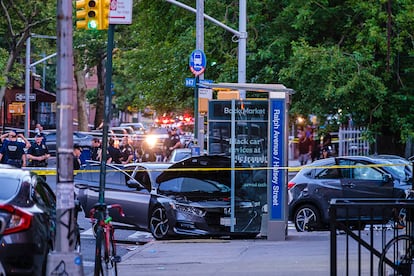Road violence sweeps the streets of New York City
Speed cameras are turned off at night and on weekends even though speeding is a frequent cause of fatal accidents


Predictions that the pandemic would bring about lasting changes to city life have been quickly debunked in New York City, especially regarding its notorious traffic. The new normal has not brought about increased use of its dysfunctional and money-losing public transportation system. Instead, an increase in the use of personal vehicles has caused a record number of accidents since 2021. Current state law mandates that the city’s speed cameras must be turned off at night and on weekends, while fatal, speed-related traffic accidents involving pedestrians and cyclists have become a daily occurrence. Some call it an “epidemic of road violence.” The controversial shutdown of speed cameras will be reversed on August 1, after intense pressure from hundreds of community groups citing proof that the vast majority of accidents happen at night and on weekends.
Traffic says a lot about a city, and in the Big Apple’s case, also about an urban design of streets built for cars and not for shared use. Fatalities are up 29% over 2018, the safest year since the Vision Zero initiative was launched in 2014 by former Mayor Bill de Blasio to promote safe driving. Several aspects of this grim statistic stand out: increasingly younger victims (11% of fatalities are under the age of 18); an increase in hit-and-run incidents (up 129% in the second quarter, compared to same period in 2019); and a 300% increase in fatalities among riders of bicycles, scooters, and motorcycles in Brooklyn.
The data was collected and analyzed by Transportation Alternatives, a non-profit organization in New York City working to change the city’s transportation priorities. Except for affluent Manhattan, residents of the other four boroughs must use the slowest public bus system in the country, averaging eight miles per hour (12km/h). Or they have to enter a subway station that is probably inaccessible to people with reduced mobility. Only about 25% of the 472 subway stations have ramps or elevators, a glaring deficiency that the transportation authority plans to alleviate by making 95% of the entrances accessible by 2055.
In June, a taxicab ran into and seriously injured a group of tourists walking near the Flatiron Building in downtown Manhattan. Three teenagers were recently killed in a head-on collision in Staten Island. A woman pushing a baby stroller died after being hit by a car in the Bronx – the driver fled the accident scene. Another woman, Karina Larino, died in April after being hit by a speeding driver as she was crossing an intersection in Queens. “It wasn’t a hit-and-run, but the driver called her own children first instead of alerting the police, while my daughter lay dying under the wheels,” sobbed the woman’s mother, who recently began helping out at Families for Safe Streets, an organization focused on confronting the epidemic of traffic violence.

Anna Melendez, the Manhattan organizer for Transportation Alternatives, says that the pandemic emptied the streets, “… so cars began using them freely… there were fewer controls, less surveillance, and more speeding.” It all boils down to “bad infrastructure and bad design,” she says, and also to inequality. “Over 50% of New York City’s public space is for roadways; 24.8% is used for car parking; 22.7% is for sidewalks; and the remaining 0.96% is for bike lanes and Open Streets,” she said. Open Streets are those that were closed to traffic during the pandemic for outdoor dining, a program that has become permanent. According to New York’s Department of Transportation, there are 1,000 dangerous intersections in the metropolitan area. Multi-lane highways often slash through the city’s poorer neighborhoods, and large trucks are allowed on almost every street.
Three deaths a day
According to Transportation Alternatives, traffic accidents kill an average of three New Yorkers every day, and seriously injure hundreds more, often with lifelong consequences and expensive health care. Statewide, traffic deaths have increased 20% since the pandemic, a US$15 billion annual drain on the economy.
Ghost Bikes is an initiative that began in Missouri in 2003 when a witness to a fatal collision between a cyclist and a car placed an all-white bike at the scene of the accident to commemorate the deceased cyclist. There are hundreds of ghost bikes all over New York City now, with plaques identifying the victims to humanize the anonymous statistics. Gustavo Ajche, the founder of Los Deliveristas Unidos, a collective of delivery workers on bikes, knows well the risks of cycling in New York City.

“Bikes, especially the electric ones, are fast and let you get around more easily,” said Ajche, “but cars still think they own the road. We’ve invested in road safety education campaigns for our members, and encourage helmet use and safe cycling. But on weekends, when there are more deliveries to be made, cars are also going faster. Two of our members were recently involved in accidents, one on his way home and the other, who is still recovering, was hit by a speeding driver at 8am on a holiday. It happened right in front of a school, so imagine what would have happened on a weekday... probably more casualties.”
Tu suscripción se está usando en otro dispositivo
¿Quieres añadir otro usuario a tu suscripción?
Si continúas leyendo en este dispositivo, no se podrá leer en el otro.
FlechaTu suscripción se está usando en otro dispositivo y solo puedes acceder a EL PAÍS desde un dispositivo a la vez.
Si quieres compartir tu cuenta, cambia tu suscripción a la modalidad Premium, así podrás añadir otro usuario. Cada uno accederá con su propia cuenta de email, lo que os permitirá personalizar vuestra experiencia en EL PAÍS.
¿Tienes una suscripción de empresa? Accede aquí para contratar más cuentas.
En el caso de no saber quién está usando tu cuenta, te recomendamos cambiar tu contraseña aquí.
Si decides continuar compartiendo tu cuenta, este mensaje se mostrará en tu dispositivo y en el de la otra persona que está usando tu cuenta de forma indefinida, afectando a tu experiencia de lectura. Puedes consultar aquí los términos y condiciones de la suscripción digital.
More information
Últimas noticias
Aquilino Gonell, former Capitol sergeant: ‘If it hadn’t been for the police, the US would be a dictatorship’
A hybrid building: Soccer pitch, housing, and a shopping mall
Europe urges Trump to respect Greenland following annexation threats
Science seeks keys to human longevity in the genetic mixing of Brazilian supercentenarians
Most viewed
- Alain Aspect, Nobel laureate in physics: ‘Einstein was so smart that he would have had to recognize quantum entanglement’
- Mexico’s missing people crisis casts a shadow over World Cup venue
- Why oil has been at the center of Venezuela-US conflicts for decades
- Alvin Hellerstein, a 92-year-old judge appointed by Bill Clinton, to preside over Maduro’s trial in New York
- Cuba confirms death of 32 of its citizens in the US attack against Venezuela










































